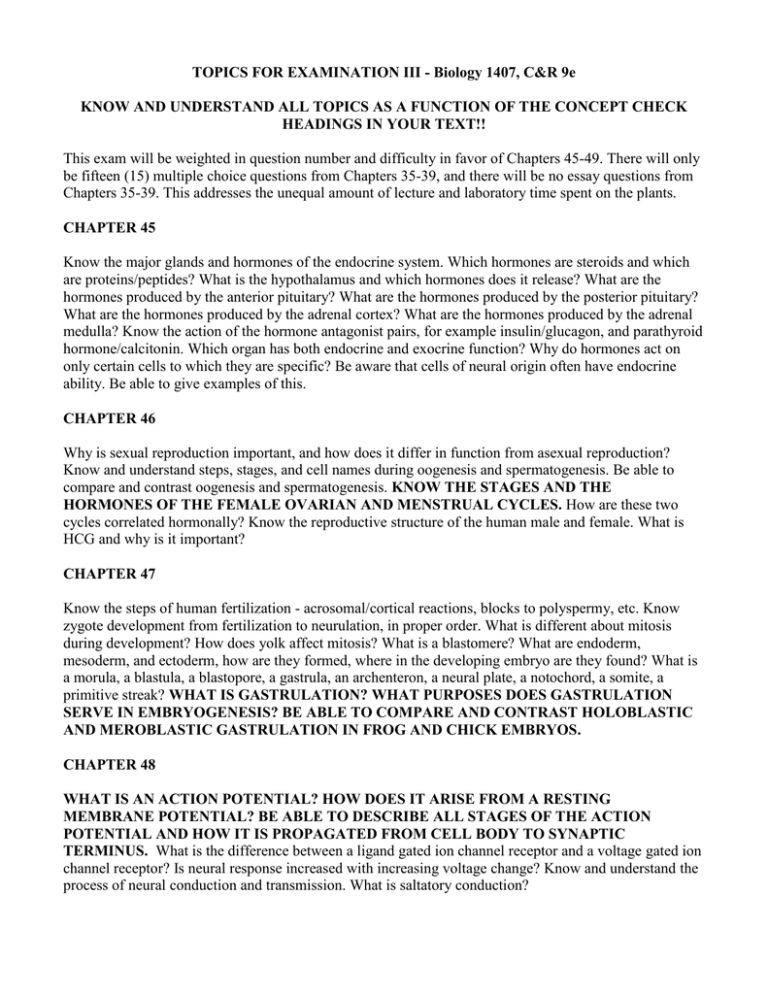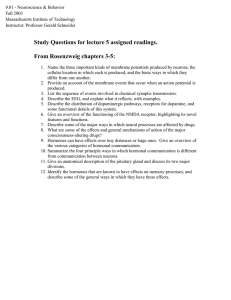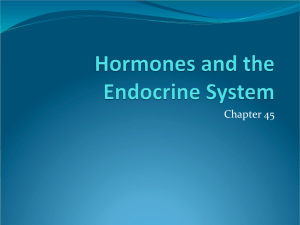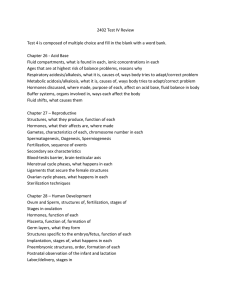1407 Exam 3 topics C R 9e.doc
advertisement

TOPICS FOR EXAMINATION III - Biology 1407, C&R 9e KNOW AND UNDERSTAND ALL TOPICS AS A FUNCTION OF THE CONCEPT CHECK HEADINGS IN YOUR TEXT!! This exam will be weighted in question number and difficulty in favor of Chapters 45-49. There will only be fifteen (15) multiple choice questions from Chapters 35-39, and there will be no essay questions from Chapters 35-39. This addresses the unequal amount of lecture and laboratory time spent on the plants. CHAPTER 45 Know the major glands and hormones of the endocrine system. Which hormones are steroids and which are proteins/peptides? What is the hypothalamus and which hormones does it release? What are the hormones produced by the anterior pituitary? What are the hormones produced by the posterior pituitary? What are the hormones produced by the adrenal cortex? What are the hormones produced by the adrenal medulla? Know the action of the hormone antagonist pairs, for example insulin/glucagon, and parathyroid hormone/calcitonin. Which organ has both endocrine and exocrine function? Why do hormones act on only certain cells to which they are specific? Be aware that cells of neural origin often have endocrine ability. Be able to give examples of this. CHAPTER 46 Why is sexual reproduction important, and how does it differ in function from asexual reproduction? Know and understand steps, stages, and cell names during oogenesis and spermatogenesis. Be able to compare and contrast oogenesis and spermatogenesis. KNOW THE STAGES AND THE HORMONES OF THE FEMALE OVARIAN AND MENSTRUAL CYCLES. How are these two cycles correlated hormonally? Know the reproductive structure of the human male and female. What is HCG and why is it important? CHAPTER 47 Know the steps of human fertilization - acrosomal/cortical reactions, blocks to polyspermy, etc. Know zygote development from fertilization to neurulation, in proper order. What is different about mitosis during development? How does yolk affect mitosis? What is a blastomere? What are endoderm, mesoderm, and ectoderm, how are they formed, where in the developing embryo are they found? What is a morula, a blastula, a blastopore, a gastrula, an archenteron, a neural plate, a notochord, a somite, a primitive streak? WHAT IS GASTRULATION? WHAT PURPOSES DOES GASTRULATION SERVE IN EMBRYOGENESIS? BE ABLE TO COMPARE AND CONTRAST HOLOBLASTIC AND MEROBLASTIC GASTRULATION IN FROG AND CHICK EMBRYOS. CHAPTER 48 WHAT IS AN ACTION POTENTIAL? HOW DOES IT ARISE FROM A RESTING MEMBRANE POTENTIAL? BE ABLE TO DESCRIBE ALL STAGES OF THE ACTION POTENTIAL AND HOW IT IS PROPAGATED FROM CELL BODY TO SYNAPTIC TERMINUS. What is the difference between a ligand gated ion channel receptor and a voltage gated ion channel receptor? Is neural response increased with increasing voltage change? Know and understand the process of neural conduction and transmission. What is saltatory conduction? How do neurotransmitters work at synapses in order to generate IPSP's and EPSP's? Understand how summation of IPSP's and EPSP's works at the axon hillock. What are the major excitatory and inhibitory neurotransmitters used in nervous systems? CHAPTER 49 What is the CNS, and what are the types and functions of the glial cells associated with it? What are the divisions of the autonomic nervous system within the PNS, and what are their general properties, relative to each other? What function are Broca's and Wernicke's regions associated with? Know the three regions of the brain, and the general control functions for which each is responsible. Be able to identify the lobes of the brain by name and position. Which is the area of highest cognition in the human brain, and where is it located? CHAPTER 50 What is sensory adaptation, and why is it important to information processing? How is hearing propagated? Know and understand the functions and relationships of the vestibular canal, the tympanic canal, the cochlear duct, the basilar membrane, the tectorial membrane, the organ of Corti, the cochlea, hair cells, tympanic membrane, the round window, the oval window. How do we maintain balance using our inner ear? What are semicircular canals? What are rod cells and cone cells? Where are they concentrated? With which type of cell do they synapse? Which of these is more sensitive to photostimulation? Which of these detect color? Know the sliding filament model of muscle contraction. Know the molecular stages of skeletal muscle contraction thoroughly, and in proper order. What are thick filaments? What are thin filaments? What is actin, myosin, troponin, tropomyosin, sarcoplasmic reticulum, transverse tubules? Which cation is important in muscle contraction, and what is its role? What is a lateral line? CHAPTERS 35 – 39 What are the major tissue types found in land plants? What is meristematic tissue? What are mycorrhizae? What is xylem and how does water move within it? What is phloem and how does sugar move within it? What are stomata and what do they do? From what does the dry biomass of a plant originate? What is nitrogen fixation, and why is it of such importance to plants? Which type of plants usually possess nitrogen fixing root nodules? What is the major genus of nitrogen fixing bacteria which are symbiotically associated with some plants? Why do plants use photoperiod to control flowering and dormancy? Why are plants important to us? Know the major plant hormones and their effects on plants. Know the names and any functions of the cells produced by the female angiosprm megaspore. What is double fertilization in angiosperms? What is endosperm, what is its ploidy, and why is it important? Know the ordered steps of alternation of generations in angiosperm plants. Where are the male and female gametophytes of flowering plants? Know the meaning of pollination and fertilization.







